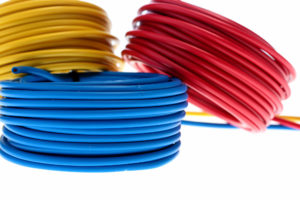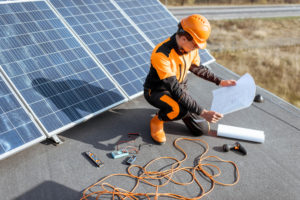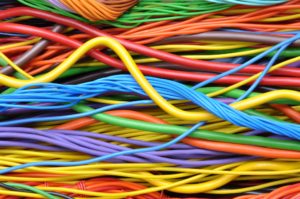Proper wire sizing is crucial in solar panel systems to ensure optimal performance, safety, and compliance. This article will explore the key factors to consider when choosing the appropriate wire size for your solar panel installation.
Contents
- 1 Understanding Wire Gauge
- 2 Calculating Wire Size for Solar Panels
- 3 Step 1: Determining the Maximum Current
- 4 Step 2: Calculating Voltage Drop
- 5 Step 3: Selecting the Appropriate Wire Size
- 6 Safety Considerations
- 7 Compliance with Electrical Codes and Regulations
- 8 Installation Best Practices
- 9 Working with Different Wire Types
- 10 Case Study: Ensuring Safety and Efficiency in Solar Installations Through Proper Wire Sizing
- 11 Expert Insights From Our Solar Panel Installers About How To Choose Solar Wire Size
- 12 Experience Solar Excellence with Us!
- 13 Conclusion
- 14 FAQ
Key Takeaways
- Proper wire sizing is crucial for solar panel systems to ensure optimal performance, safety, and compliance with electrical codes and regulations.
- Choosing the right wire size involves considering factors such as wire gauge, voltage drop, system voltage, distance between panels and controllers, and total wattage and amperage.
- Safety considerations include fire safety, heat dissipation, UV and weather resistance, and adherence to electrical codes and regulations. Consulting with professionals and obtaining permits and inspections are essential for a safe and reliable solar panel system.
Understanding Wire Gauge
Wire gauge refers to the thickness or diameter of a wire. It is vital in determining the wire’s ampacity or current-carrying capacity. The most commonly used gauge standard for solar panel systems is the American Wire Gauge (AWG).
Calculating Wire Size for Solar Panels
Choosing the right wire size for your solar panel system requires a systematic approach considering various factors. By following these steps and calculations, you can ensure efficient and safe wiring in your solar installation.
Step 1: Determining the Maximum Current
To begin, you need to determine the maximum current output of your solar panels. This information can typically be found in the manufacturer’s specifications. Remember that the maximum current may vary based on factors such as temperature and shading. It is essential to consider worst-case scenarios when calculating wire size to ensure optimal performance in all conditions.
Step 2: Calculating Voltage Drop
Voltage drop is crucial when selecting wire size for your solar panel system. Excessive voltage drops can result in power losses and reduced system efficiency. To calculate the voltage drop, you’ll need to consider several factors, including wire length, current, and wire gauge.
Wire Length
The length of the wire refers to the distance between your solar panels and the charge controller or battery bank. Longer wire lengths result in increased resistance, leading to higher voltage drop. Minimizing wire length is ideal for reducing losses, but longer wires are often necessary for practical installations.
Current
Your solar array’s total wattage and amperage determine the current flowing through the wire. When calculating wire size, it is essential to consider the nominal current and any potential future expansions or upgrades.
Wire Gauge
Wire gauge, often measured using the American Wire Gauge (AWG) standard, determines the cross-sectional area of the wire. A larger gauge number corresponds to a smaller wire diameter. Regarding wire gauge selection, it’s crucial to balance current-carrying capacity and voltage drop.
Step 3: Selecting the Appropriate Wire Size
Once you have calculated the maximum current and voltage drop, you can select the appropriate wire size for your solar panel system. Choosing a wire gauge that can handle the maximum current without causing an excessive voltage drop is important.
AWG Chart
The AWG chart provides a reference for selecting the right wire size based on current capacity and voltage drop limitations. For instance, a lower gauge number, such as 10 gauge, indicates a larger wire size that can handle higher currents than a higher gauge number, like 12 gauge.
System Voltage
Consider the system voltage of your solar panel installation. Higher system voltages result in lower current levels, allowing for smaller gauge wires. However, higher voltages also have safety considerations, so following electrical codes and regulations is crucial.
Distance from Panels to Battery Bank or Charge Controller
The distance between your solar panels and the battery bank or charge controller affects the voltage drop. Longer distances require larger wire sizes to compensate for increased resistance. Consider the total length for the positive (red) and negative (black) wires to ensure balanced voltage distribution.
Total Wattage and Amperage
Take into account the total wattage and amperage of your solar array. If you plan to expand your system, consider the potential increase in current and choose a wire size that can accommodate the anticipated growth.
You can confidently select the appropriate wire size for your solar panel system by carefully considering these factors and performing the necessary calculations. Remember, undersized wires can result in power losses, increased voltage drop, and potential safety hazards. Consult with professionals and adhere to local regulations to ensure the best outcomes for your solar installation.

Safety Considerations
Ensuring safety is paramount when choosing wire sizes for your solar panel system. Here are some key safety considerations to keep in mind:
Fire Safety and Heat Dissipation
Proper wire sizing is crucial in fire safety and heat dissipation within your solar panel system. Undersized wires can generate excessive heat, increasing the risk of fire. To mitigate this risk, choosing wire sizes that can handle the system loads without overheating is essential.
Heat Dissipation
Wires too small for the current flowing through them can become hot, causing insulation damage and potential fire hazards. Properly sized wires have lower resistance, which helps dissipate heat effectively. This not only prevents fire hazards but also ensures the longevity of your system.
Electrical Codes and Regulations
Adhering to electrical codes and regulations is vital for fire safety. These codes specify the minimum wire size required for different current-carrying capacities. Consult with local authorities or electrical professionals to ensure compliance with your area’s applicable codes and regulations.
UV and Weather Resistance
Since solar panel systems are typically installed outdoors, the wires should have appropriate insulation materials that provide UV and weather resistance. This is crucial to protect the wires from degradation caused by prolonged exposure to sunlight and environmental elements.
Insulation Materials
When selecting wire sizes for your solar panel system, choose wires with insulation materials specifically designed for outdoor use. These materials should be capable of withstanding UV radiation, extreme temperatures, and moisture. High-quality insulation ensures long-term durability and prevents premature wire failure.
Physical Protection
In addition to UV resistance, protecting the wires from physical damage is essential. Wires should be properly routed and secured to prevent being accidentally cut or damaged by external factors such as wildlife, falling debris, or human activities. Consider using conduits, cable trays, or raceways to provide an extra layer of physical protection.
Compliance with Electrical Codes and Regulations
To ensure the safety and reliability of your solar panel system, it is crucial to comply with electrical codes and regulations specific to your location. These codes protect against electrical hazards and promote safe installation practices.
Professional Consultation
Consulting with professionals, such as licensed electricians or solar installers, is highly recommended when determining wire sizes for your solar panel system. They can provide expert advice, ensure compliance with local electrical codes, and perform quality installations that meet safety standards.
Permitting and Inspection
In many jurisdictions, solar panel installations require permits and inspections to verify compliance with electrical codes and regulations. These processes help ensure that the wiring and overall system meet safety standards. Always check with the local building department to understand your solar panel installation’s permitting and inspection requirements.
You can ensure a safe and reliable solar panel system by prioritizing fire safety, heat dissipation, UV and weather resistance, and compliance with electrical codes and regulations. Proper wire sizing, professional guidance, and adherence to standards will contribute to your installation’s long-term performance and safety.

Installation Best Practices
Proper installation practices are essential for maximizing the functionality and longevity of your solar panel system. Here are some key considerations and best practices to follow during the installation process:
Proper Wire Routing and Protection
The routing of wires in your solar panel system should be carefully planned to minimize exposure to environmental hazards and potential damage. Follow these best practices for wire routing:
Environmental Hazards
Consider the environmental conditions surrounding your solar panel installation. Avoid routing wires through areas prone to excessive heat, moisture, or direct sunlight. Consider any potential risks, such as exposure to chemicals or corrosive substances.
Conduits, Cable Trays, and Raceways
Consider using conduits, cable trays, or raceways to protect your wires from physical damage. These protective channels help keep the wires organized, secure, and shielded from external elements. Be sure to choose materials compatible with outdoor installations and suitable for your specific environmental conditions.
Proper Securing and Fastening
Properly secure and fasten the wires along their entire length. Use appropriate fasteners, clips, or ties to ensure the wires are held in place and not subject to excessive movement or strain. This helps prevent potential damage to the wires and ensures the long-term stability of your system.
Labeling and Organizing Wires
Clear labeling and organization of wires are crucial for easy maintenance, troubleshooting, and future system expansions. Follow these labeling best practices:
Identification Labels
Label each wire with clear and permanent identification tags or markers. Use labels that are resistant to fading, moisture, and UV exposure. Include relevant information such as wire purpose, source, destination, and necessary polarity indicators.
Color Coding
Consider using a color-coding system to differentiate between wires based on their function or voltage level. This visual distinction can simplify troubleshooting and maintenance activities, especially in larger solar panel systems.
Documentation
Maintain accurate documentation of the wire routing, connections, and labeling scheme. This documentation is valuable for future system modifications, upgrades, or repairs. It also aids in ensuring compliance with electrical codes and regulations.

Working with Different Wire Types
Solar panel installations may involve different wire types based on specific requirements and environmental conditions. Here are some considerations when working with different wire types:
Copper Wire
Copper wire is commonly used in solar panel systems due to its excellent conductivity and corrosion resistance. It is suitable for both indoor and outdoor installations. Ensure the selected copper wire meets your system’s requirements and specifications.
Aluminum Wire
In some cases, aluminum wire may be used as an alternative to copper wire. However, it is essential to consult with professionals and adhere to the guidelines and requirements for aluminum wiring. Proper terminations, connectors, and anti-oxidant compounds should be used to mitigate potential issues associated with aluminum wire.
Environmental Compatibility
Consider the environmental conditions your wires will be exposed to when selecting wire types. Ensure that the chosen wire type is suitable for outdoor use, providing resistance to UV radiation, temperature variations, moisture, and other environmental factors specific to your location.
Case Study: Ensuring Safety and Efficiency in Solar Installations Through Proper Wire Sizing
Background
Solar Panels Network USA was tasked with designing and installing a solar energy system for a residential property. The challenge was to ensure the system’s safety and efficiency, considering the significant distance between the solar panels and the battery bank.
Project Overview
The project required careful selection of wire size to handle the system’s power needs while minimizing voltage drop and ensuring compliance with electrical codes. Key factors included calculating the maximum current, voltage drop, and selecting the appropriate American Wire Gauge (AWG) wire size.
Implementation
Step 1: Determining the Maximum Current
We began by calculating the maximum current output of the solar panels based on the manufacturer’s specifications, considering worst-case scenarios to ensure the chosen wire could handle the peak loads.
Step 2: Calculating Voltage Drop
To maintain system efficiency, we calculated the potential voltage drop over the distance between the panels and the battery bank. This involved considering the wire length, current, and gauge. Minimizing voltage drop was crucial to prevent power loss and ensure optimal performance.
Step 3: Selecting the Appropriate Wire Size
Using the AWG chart, we selected a wire gauge that could handle the calculated maximum current with minimal voltage drop. This ensured the wire could support the system’s electrical load without overheating or causing efficiency losses.
Results
By following these steps, we selected a 10-gauge wire for the main connections, ensuring it could handle the maximum current and reduce voltage drop to acceptable levels. This choice not only met the electrical demands but also adhered to safety standards, preventing overheating and potential fire hazards.
Summary
This case study highlights the importance of proper wire sizing in solar panel installations. By meticulously calculating the maximum current and voltage drop, and selecting the appropriate wire gauge, we ensured the system’s efficiency, safety, and compliance with electrical codes. Consulting with professionals and adhering to industry standards were key factors in the successful implementation of this solar energy system.
Expert Insights From Our Solar Panel Installers About How To Choose Solar Wire Size
Choosing the correct wire size is essential for ensuring your solar panel system operates efficiently and safely. Undersized wires can lead to power loss and potential safety hazards, making it crucial to consider all factors like wire gauge and voltage drop.
Senior Solar Installer
The importance of wire gauge cannot be overstated. A properly sized wire helps in heat dissipation and maintains system efficiency, which is vital for both performance and safety.
Lead Technician
Working with professionals to determine the appropriate wire size ensures compliance with electrical codes and regulations, which is critical for the long-term reliability of your solar installation.
Solar Installation Specialist
Experience Solar Excellence with Us!
Trust in Solar Panels Network USA, where our seasoned experts deliver top-quality solar solutions for homes and businesses nationwide. With a legacy of countless successful installations and a commitment to sustainable energy, we’re your reliable partner in the solar journey. Ready for a brighter, eco-friendly future? Call us now at (855) 427-0058 and harness the sun’s power!
Conclusion
Choosing the right wire size for your solar panel system is crucial for optimal performance, safety, and compliance. Following the steps outlined in this article and considering factors such as wire gauge, voltage drop, and safety considerations, you can ensure a well-designed and efficient solar panel installation. Remember to consult professionals and adhere to local regulations for the best results.
FAQ
Here are answers to some frequently asked questions about choosing the right wire size for your solar panel system:
What is the best wire for solar wiring?
The best wire for solar wiring depends on various factors, including the specific requirements of your system, local regulations, and environmental conditions. Copper wire is commonly used due to its excellent conductivity and corrosion resistance. It is important to consult with professionals and adhere to relevant standards and specifications for your installation.
Can I use 8 gauge wire for solar panels?
The wire gauge required for your solar panels depends on the maximum current output, voltage drop limitations, and system configuration. While 8 gauge wire may be suitable for some solar panel systems, it is essential to perform the necessary calculations and consult with professionals to ensure the wire size can handle the anticipated current without excessive voltage drop.
How do I know what size wire I need?
To determine the appropriate wire size for your solar panel system, consider the maximum current output, voltage drop limitations, system voltage, distance from panels to the battery bank or charge controller, and total wattage and amperage of your solar array. You can select the wire size that meets these requirements by performing calculations and referring to wire gauge charts.
Do I need a special wire for solar?
Using special wire designed for solar applications is highly recommended. Solar-specific wires are designed to withstand outdoor conditions, UV radiation, temperature variations, and moisture. These wires have appropriate insulation materials that provide durability and longevity in solar panel systems. Selecting wires that meet relevant industry standards and regulations is important to ensure your solar installation’s safe and efficient operation.
About the Author
Solar Panels Network USA stands at the forefront of solar energy solutions, driven by a team of seasoned solar engineers and energy consultants. With over decades of experience in delivering high-quality solar installations and maintenance, we are committed to promoting sustainable energy through customer-centric, tailored solutions. Our articles reflect this commitment, crafted collaboratively by experts to provide accurate, up-to-date insights into solar technology, ensuring our readers are well-informed and empowered in their solar energy decisions.

